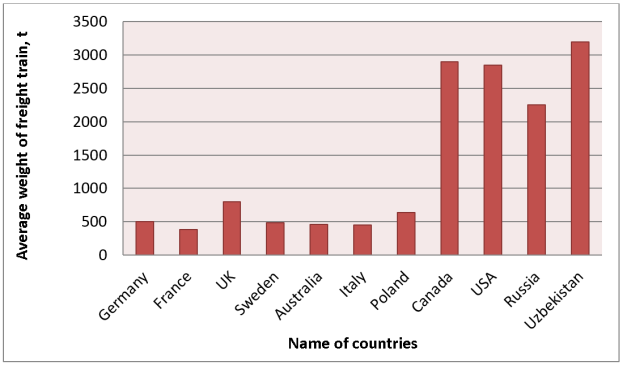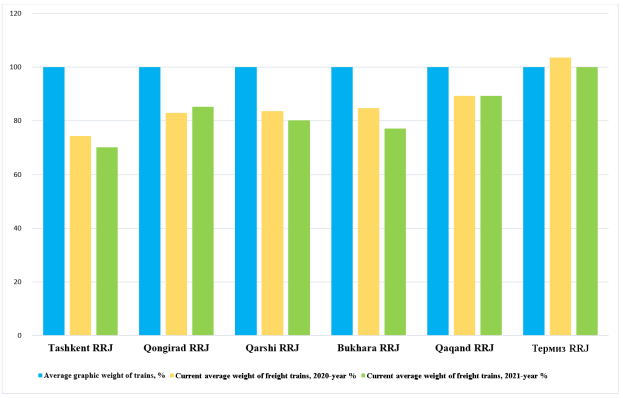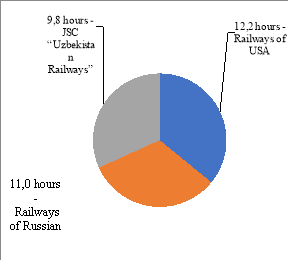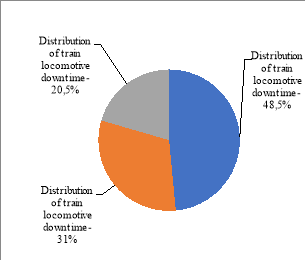Due to the presence of freight trains of different categories on the railway sections, there are deviations from the performance of the normal weight of trains. This, in turn, affects the performance of locomotives. This article examines the performance of JSC «Uzbekistan Railways» and freight locomotives and trains on the railway sections of foreign countries, based on the analysis of the performance of the standard weight of freight trains, shows the need to differentiate these standards based on the characteristics of the railway section.
Keywords: freight trains, weight norm, train weight, use of locomotives, use of locomotives daily working hours.
В связи с тем, что на железнодорожных участках осуществляется движение грузовых поездов разных категорий, наблюдаются отклонения от показателей нормативного веса поездов. Это, в свою очередь, влияет на показатели использования локомотивов. В данной статье были исследованы показатели использования грузовых локомотивов и поездов железнодорожных участков АО «Узбекистан темир йуллари» и зарубежных стран, на основе анализа выполнения нормативного веса грузовых поездов показана необходимость установления этих норм в дифференцированном порядке с учетом характеристики железнодорожных участков.
Ключевые слова: грузовые поезда, норма веса, вес поезда, эксплуатация локомотивов, суточный бюджет полезной работы локомотивов.
INTRODUCTION In order to further develop the railway network of the country, electrify sections and increase the efficiency of passenger and freight traffic through the introduction of modern technologies, the need for modern electric trains with all conveniences, improving the transport infrastructure, providing quality and safe transport services to passengers is increasing.
Currently, there is a growing demand for the use of locomotives, which are one of the main components of rail transport abroad and in the country, including locomotive farms, brigades and depots, locomotive maintenance points, workshops, etc. The utilization rate of locomotives in JSC “Uzbekistan Railways” is not high. The full use of the normal weight of freight trains at JSC “Uzbekistan Railways” will also have an impact on the growth or decline of key indicators. In the [1] according to the report of JSC “Uzbekistan Railways” on the results of 2017, the daily working time of locomotives was 9.8 hours. This means that the locomotives are idle for more than half a day (14.2 hours). This figure is 11 hours on Russian Railways and 12.2 hours on USA railways (figure 1).
|
|
Figure 2. Distribution of train locomotive downtime in 2018 |
The main reasons for the delay of locomotives are their untimely commissioning and assembly of trains at rotating stations, non-fulfillment of the normative weight, and stopping of locomotives at the stations where they are attached (figure 2).
The analysis of these figures, in turn, shows the need to introduce innovative technologies in the efficient use of locomotives.
LITERATURE ANALYSIS AND METHODOLOGY In the [2] scientific work provides recommendations for systematization and generalization of materials related to the operation of locomotives, analysis of shortcomings in this important network of railway transport and further improvement of the performance of scientifically based, practically tested locomotives. In particular, in this work, analytical formulas for determining the standby time of freight locomotives are proposed. In the [3] study of the current state of use of freight locomotives and the analysis of scientific work. As a result, in calculating the fleet of locomotives in freight traffic, the condition «no train will absolutely wait for the locomotive to depart from the station» was used. In most cases, failure to meet this condition resulted in an increase in the downtime of locomotives at turning points, which was considered by using modeling to change the figure for the better. In the [4] study examined the effect of standby time on the locomotive fleet at the point of rotation of freight locomotives. As a result, it was found that the waiting time of freight trains at the turning points of locomotives of the same size varies in certain intervals, and it is scientifically based that the degree of accuracy is not high when determining the magnitude of this time by analytical formulas.
In this [5–13] research, it has been studied the impact of train locomotives on the performance of locomotives, increasing the efficiency of locomotives, automating the process of calculating the fleet of locomotives, the section speed of trains.
Methodological recommendations include basic concepts and definitions of locomotive operation technology, calculation of locomotive fleet according to the established schedule, trains and their main indicators, the impact of analytical use factors on locomotive performance, as well as the use of computer technology in regulating these indicators. The main goal of the above research is to improve the efficiency of locomotives with the lowest cost, maximum profit.
The average standard weights of freight trains on the railways of the Republic and in other countries were analyzed (figure 3). Figure 3 shows that in most foreign countries, both low-capacity and standard weight freight trains run several times less. The fact that the number of wagons in the train is less than the norm leads to an increase in the number of trains on the section and the number of locomotives required, which in turn leads to an increase in the cost of towing trains.
The average graphic weight of trains at JSC “Uzbekistan Railways” is 3400 tons for single-track, 3447 tons for double tracks (indicator for the general type of traction), ie according to the plan freight trains should run with an average weight of 3423 tons, but the current average weight is 3200 tons. is formed. In particular, the performance of the actual weights of the average freight trains set for the last two years at the regional railway junctions is shown in figure 4.

Figure 3. Average weight of freight trains on the railways of “Uzbekistan” Railways JSC and other countries
The results of the analysis show that the established average normative weight was fulfilled by 86 % in 2020 and by 84 % in 2021 (figure 4). In particular, it can be seen that in Tashkent RRJ 26 % of the normative weight of freight trains was not used in 2020 and 28 % in 2021 (figure 4). These, in turn, necessitate an analytical study of the factors influencing the decline in the current indicator. One of the main reasons for the decline in the number of mainline locomotives is the large number of reserve trains.
Figure 4 shows that in 2020, the Termez regional railway junction was used in excess of the normal weight of freight trains.
An increase in train weight and length leads to an increase in train assembly time. At the same time, the number of trains will be reduced, and the volume and processing time of wagons at sorting stations will be increased, which will increase the operating costs and wagon turnover.
The average train weight set by Uzbekistan Railways varies on different sections. The main indicators that determine the average standard weight of freight trains are: traffic volume, traction capacity of locomotives, station receiving and dispatching, useful track length of sorting tracks and load-carrying capacity of the wagon. Also, the weight of the train determines the capacity of road and man-made structures, the parameters of the technical equipment of railway stations, the design of wagons and locomotives.
The weight of trains is reflected in the performance and economic performance of the rolling stock. Train traffic standards and related indicators determine the technology of operation of stations, in particular, the duration of shunting operations on the construction, distribution, reconstruction of trains, the time of assembly and delivery of wagons and trains, the volume of cargo in motion. Therefore, the weight of the train is the most important factor determining the organization, technology and economy of the movement process.
The standard weight of freight trains determines the power of traction, the calculated slope, the specific resistance to the movement of wagons and locomotives, or the useful length of the station receiving-sending routes. The standard weight of freight trains determines the optimal option for efficient use of locomotive power.
Determining the standard weight of freight trains on section routes is not only a technical but also an economic task. Technically, it maximizes the costs associated with the development and equipping of roads, the use of shunting power, the throughput and carrying capacity of lines, and thus the organization of traffic. Distribution of locomotives, including attachment to components, requires consideration of the possibility of applying full or partial traction or pushing. DISCUSSION AND RESULTS The standard weights of freight trains of JSC “Uzbekistan Railways” on the routes of Tashkent RRJ are defined as follows (table 1).
Table 1
Standard weights of freight trains at the intersection of routes of Tashkent RRJ, t
|
Directions |
2VL60 K |
3VL80 C |
Uzbekistan 1 section |
Uzbekistan 2 sections |
||||
|
even |
odd |
even |
odd |
even |
odd |
even |
odd |
|
|
Weight of freight trains (tons) |
||||||||
|
North |
3880 |
4500 |
3880 |
4500 |
2800 |
3000 |
3800 |
4500 |
|
South |
3880 |
4500 |
3880 |
4500 |
2800 |
2800 |
3800 |
4500 |
|
Khojikent |
3550 |
4075 |
5500 |
5500 |
2300 |
2800 |
5300 |
5300 |
|
Angren |
4500 |
3500 |
4500 |
3000 |
3400 |
2000 |
4000 |
2300 |

Figure 4. Fulfillment of the normative and current average weight of freight trains of regional railway junctions of JSC “Uzbekistan Railways” in 2020–2021
The average weight of freight trains and the number of wagons in the composition are determined by the following formulas:


|
where |
|
distance covered by different types of trains, km; |
|
|
weight standards of different types of freight trains, tons; |
|
|
|
the number of wagons in freight trains of different types, wagons; |
|
|
|
the number of trains of different weights. |
|
Table 2
Analysis of the series of locomotives servicing the sections of Tashkent RRJ in 2020–2021 (traction type electric locomotive), the average graphic weight of the train and the current average weight of the train
|
№ |
Service areas |
Locomotive series |
Average graphic weight of the train, t |
Average train weight in use, t |
||||
|
odd |
couple |
2020 |
2021 |
|||||
|
even |
odd |
even |
odd |
|||||
|
1 |
Sari-Agach — Keles |
3VL80 C , VL80 С , 2VL60 К , Uzbekistan 1 section, Uz-EL(R), 2Uzbekistan, 2Uz-EL(R). |
3550 |
4125 |
1606 |
4014 |
1730 |
3926 |
|
2 |
Uzbekistan — Tashkent cargo |
3550 |
4125 |
2874 |
3098 |
2973 |
3155 |
|
|
3 |
Syrdarya — Uzbekistan |
3550 |
4125 |
2401 |
3733 |
2486 |
3719 |
|
|
4 |
Angren- Toqimachi |
3325 |
2525 |
2247 |
3488 |
2643 |
3228 |
|
|
5 |
Salar — OP Chinor |
3550 |
4125 |
1598 |
2863 |
1392 |
2833 |
|
|
6 |
Uzbekistan — Keles |
3550 |
4125 |
1871 |
4101 |
1819 |
3856 |
|
|
7 |
Jizzah — Dashtabod |
3550 |
4075 |
2927 |
3509 |
3036 |
3415 |
|
|
8 |
Jizzah — Ettisoy |
3550 |
4075 |
1611 |
3512 |
1699 |
3335 |
|
|
9 |
Paxtaorol — Sirdaryo |
3550 |
4075 |
1182 |
3407 |
818 |
364 |
|
|
10 |
Havast — Sirdaryo |
3550 |
4125 |
2495 |
3667 |
2539 |
3651 |
|
The average graphic weight of the train and the average weight of the current train were analyzed by series of locomotives (traction type electric locomotive) serving the sections of Tashkent RRJ of JSC “Uzbekistan Railways” (table 2). As a result, it can be seen that the average train weight acting on an odd route is partially 50 % of the normal average train weight [1]. Of the above train types, the impact of the reserve train is greater because, as the number of reserve trains increases, the weight of the train does not increase. If we look at the example of Tashkent RRJ station “N”, the trains built at this station are mainly divided into 4 routes: North, South, Angren and Khojikent. The type of electric traction is applied to the routes. 2VL60 K , 3VL80 C , Uzbekistan 1, 2 series electric locomotives are mainly used in these routes.
The weight of the freight train is calculated by the formula


|
where |
|
rated traction power of the locomotive, kgf; |
|
Р – |
rated weight of the locomotive, tons; |
|
|
|
given calculated slope; |
|
|
|
basic resistance to locomotive motion, kgf/t; |
|
|
|
the basic resistance to the movement of wagons at the rated speed, kgf/ t. |
|
The main resistance to the movement of the locomotive is calculated on the basis of the following expression

where is

The basic resistance to the movement of wagons is calculated on the basis of the following expression

where is

Table 3
Results of calculations on the characteristics and slope of the train locomotives serving the section under study
|
Directions |
Locomotive series |
F кр , kgs |
|
P, t |
L, m |
|
q 04 , t/arrow |
ω 0 ' , kgf/t |
ω 04 '' , kgf/t |
Ԛ бр , t |
|
North |
2VL60 К |
36800 |
43,5 |
138 |
42 |
5,4 |
21,4 |
2,903 |
1,265 |
5200 |
|
3VL80 С |
49000 |
44,2 |
184 |
99 |
2,928 |
1,275 |
7150 |
|||
|
UZBEKISTAN |
45000 |
53,0 |
138 |
28 |
3,273 |
1,416 |
6500 |
|||
|
South |
2VL60 К |
36800 |
43,5 |
138 |
42 |
6,4 |
2,903 |
1,265 |
4650 |
|
|
3VL80 С |
49000 |
44,2 |
184 |
99 |
2,928 |
1,275 |
6200 |
|||
|
UZBEKISTAN |
45000 |
53,0 |
138 |
28 |
3,273 |
1,416 |
5600 |
|||
|
Khojijent |
2VL60 К |
36800 |
43,5 |
138 |
42 |
5,3 |
2,903 |
1,265 |
5450 |
|
|
3VL80 С |
49000 |
44,2 |
184 |
99 |
2,928 |
1,275 |
7250 |
|||
|
UZBEKISTAN |
45000 |
53,0 |
138 |
28 |
3,273 |
1,416 |
6550 |
|||
|
Angren |
2VL60 К |
36800 |
43,5 |
138 |
42 |
5,9 |
2,903 |
1,265 |
5000 |
|
|
3VL80 С |
49000 |
44,2 |
184 |
99 |
2,928 |
1,275 |
6600 |
|||
|
UZBEKISTAN |
45000 |
53,0 |
138 |
28 |
3,273 |
1,416 |
6000 |
Although the schedule in each direction sets a certain norm for the weight of trains, the actual weight deviates from the norm in a very wide range. The calculated weight standards are mainly set based on the strength of the traction structure and the road profile in the section or direction. It is also determined relative to the useful path length of the content station receiving and sending routes. In addition, due to the non-uniformity of the wagon flow, some compositions are formed at a weight less than the specified norm, while others are at a maximum.
CONCLUSION In case of exceeding the graphic weight of the freight train, additional locomotives will be involved in the route. In this case, the traction tool is considered overused. Conversely, when the graphic weight of freight trains is below the norm, the capacity of traction vehicles is often not fully utilized.
The standard weight of North, South, Khojakent and Angren trains can be 1000–5500 t and more. In 2020–2021, the current weight of trains from Tashkent MTU will be 1000–3500 tons to the north, 2000–3500 tons to the south, 1500–3000 tons to Khojakent and 2000–3500 tons to Angren. 2500 t and more, Khojakent 1500 t and more and Angren 2500 t and more.
From the above analysis, it can be seen that the rational setting of train weight standards on the section has a significant impact on the performance of locomotives, and one of the important factors is the determination of the normative weight on the section, taking into account the above standards.
References:
1. Машарипов М. Н. Поезд локомотивлари эксплуатацияси транспорт жараёнларининг инновацион технологиялари. Техника фанлари бўйича фалсафа доктори (PhD) илмий даражасини олиш учун тайёрланган диссертация. Тошкент: ТТЙМИ. — 2019. — 177 с.
2. Некрашевич В. И., Апацев В. И. Управление эксплуатацией локомотивов: уч. пос.: — М.: РГОТУПС, 2004. — 257 с.
3. Айзинбруд C. Я., Кельперис П. И. Эксплуатация локомотивов. — 2-е изд., перераб. и доп. — М.: Транспорт, 1990. — 261 с.
4. Masharipov, M. N., Suyunbaev, S. M., & Rasulmukhamedov, M. M. (2019). ISSUES OF REGULATION OF TRAIN LOCOMOTIVES OF THE RAILWAY SECTION CHUKURSAY-SARYAGASH. Journal of Tashkent Institute of Railway Engineers, 15(3), 144–154.
5. Masharipov, M. N., Rasulov, M. K., Rasulmukhammedov, M. M., & Suyunbaev, S. M. (2019). Raschet ekspluatiruemogo parka gruzovykh lokomotivov grafoanaliticheskim metodom na yazyke programmirovaniya C#. Intellectual Technologies on Transport, 17, 5–12.
6. Куанышбаев, Ж. М., Суюнбаев, Ш. М., & Машарипов, М. Н. (2019). Исследование локомотивных составляющих в интермодальных и юнимодальных перевозках. Наука и мир, 1(6), 43–49.
7. Суюнбаев, Ш. М., Жумаев, Ш. Б. Ў., Бўриев, Ш. Х. Ў., & Туропов, А. А. Ў. (2021). ТЕМИР ЙЎЛ УЧАСТКАЛАРИДА МАҲАЛЛИЙ ВАГОНЛАР ОҚИМИНИ ТУРЛИ ТОИФАДАГИ ПОЕЗДЛАР БИЛАН ТАШКИЛ ЭТИШ УСУЛЛАРИНИ ТЕХНИК-ИҚТИСОДИЙ БАҲОЛАШ. Academic research in educational sciences, 2(6), 492–508.
8. Rasulov, M. X., Rasulmukhamedov, M. M., Suyunbayev, S. M., & Masharipov, M. N. (2020). AUTOMATION OF THE PROCESS OF ATTACHING LOCOMOTIVES TO TRAINS IN CONDITIONS OF A NON-PAIRING GRAPHICS. Journal of Tashkent Institute of Railway Engineers, 16(2), 49–65.
9. Расулов, М. Х., Машарипов, М. Н., Расулмухамедов, М. М., & Суюнбаев, Ш. М. (2019). Выбор рациональной технологии увязки локомотивов на приграничном пункте пропуска «Ок куприк-железнодорожный». Universum: технические науки, (10–1 (67)).
10. Aripov, N. M., & Vladimirovich, R. A. (2021). Rapid planning of mixed-structure train organization in the context of non-proportional wagon-flows. International Journal of Discoveries and Innovations in Applied Sciences, 1(5), 324–335.
11. Бутунов, Д. Б., Суюнбаев, Ш. М., & Ахмедова, М. Д. (2021). Особенности построения стохастической модели оценки параметра непроизводительных потерь. Academic research in educational sciences, 2(11), 348–362.
12. Суюнбаев, Ш. М., & Имяминов, Б. А. (2016). Энергосбережение на новом железнодорожном участке А-П. Наука и инновационные технологии, (1), 94–96.
13. Суюнбаев, Ш. М., & Зухретдинов, А. С. (2016). Мероприятия по усилению пропускной способности участка с-к в условиях скоростного движения пассажирских поездов. Наука и инновационные технологии, (1), 282–284.
14. Правила тяговых расчетов для поездной работы. — М.: Транспорт, 1985. — 287 с.



















